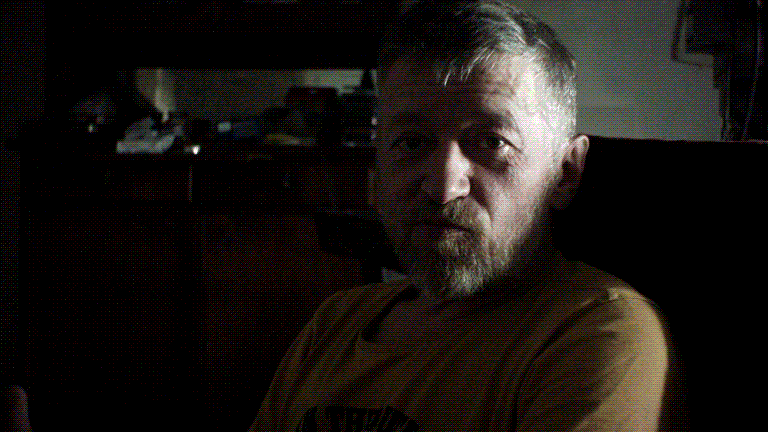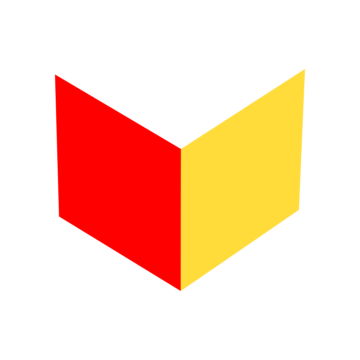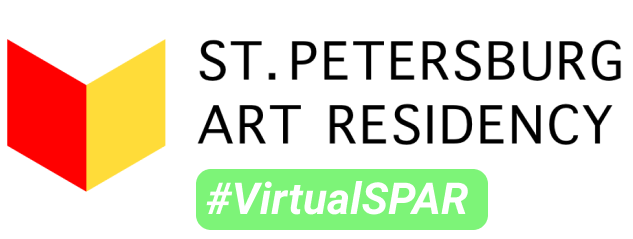The Interview with Boris Kazakov by M. Stebackov. Part 2/4
The Interview was recorded on the 2nd of August in 2022 at Boris Kazakov’s place.
The text of the interview is published in 4 parts.
- Boris Kazakov’s Brief Biography
- The Interview
Интервью было записано 2-го августа 2022 года в доме у Бориса Казакова.
Текст интервью опубликован в 4-х частях.

The Interview
Michael Stebackov: How did the images in the film “Stakes” emerge?
Boris Kazakov: There was an earlier film “Nestlings of Sea.” It was my first independent experience in animation cinema, and for me it became clear that this way was possible. When I had the footage for the “Stakes,” the one that Yufit gave me, then I decided to make a more sensible version. The idea was just to make a shorter version of his film, and I was building it upon this idea. I had to convey to the spectator the actions that took place in Yufit’s film, and the meanings that were brought to the spectator of the Yufit’s film. That was my task. By having fun or by cutting the film away, no matter how I was preserving solely the film’s structure. Proceeding from the objective, I was adding things and was making some other things. I would regard the “Stakes” as a newsreel for the “Silver Heads.” This way it would be right to interpret, just because the films are chronologically following each other (laughing). If you screen the “Stakes” first, and then screen the “Silver Heads,” I’m afraid not everyone will withstand the show. But if you say this is a long version, and this is a short version, watch or leave. That’s why I think the percentage of leavings would be equal to zero (laughing). What’s going on in Yufit’s film? The hybrid of a human and a tree is being created by placing a human being into a capsule measuring as big as a small country toilet, where a human is stabbed by the stakes from all sides and strewed by the wooden chips from above. The stakes are going out from the sides of the capsule. Some stakes are already running everywhere. I questioned the meaning of a stake in the Yufit’s film. The propulsive agent of the automobile is a wheel, the yacht’s one is a sail, and what feature is here? The stake is the character. Black little men, of course, and some stakes and different firs are showing up. They begin living their lives.
M. S.: The story of “The Doctors and the Huts” is rooted in necrorealism, isn’t it?
B. K.: No, it is not. Speaking of images, there is a hut on chicken legs. I’ve seen this image with Vadim Ovchinnikov. He treated the image very seriously, it was called “The She-Guest from the Future.” When you start to rumple, roll, or drag something, willy-nilly, you start to recognize the facets of the object. The hut in my epic story is not a hut as a house. It is a sign of a paradox. It is like a real estate, but at the same time, it can stand on its legs and go somewhere out of harm’s way, or on the contrary — towards adventures. That is the one side. The other is that the hut on chicken legs is a house, but a house like the house of Romanovs, the house of Ivanovs, the house of someone else. It is their kin, which originates somewhere and probably will end somewhere, but for now, it lasts, and most likely it will continue to last. That’s why if someone has left a hut, he or she could be its plenipotentiary. As soon as I got the idea of the story, then it became interesting. That was on the huts.
M. S.: What about the Doctors’ side?
B. K.: The Doctors is an organization, isn’t it? The organization which always wants to take you out of the hut and place you into its cell, do you understand? The task of a rational individual is to resist, isn’t it? Since the organization should be structured somehow, I thought that the Doctors should fit. For example, if you take the case of the military or priests, you can get in trouble, so in the case of the Doctors, they are doctors and nothing else. They are easily recognizable. They are simple to draw. The image is clear, and you can give them features you like: from a hospital attendant to a sexy girl in a short doctor’s smock. That’s the way the Huts and their friends, the Doctors, have appeared (laughing).
M. S.: Can the Doctors as an organization be related to the theme of scientific experiments in necrorealist films?
B. K.: No. What was used in the necrorealism? There are plenty of images that are used, but I want to mention the Soviet affectedness. In childhood, when we played in the war, we were using clichés from Soviet films: “Drop it! You won’t be able to carry me!” In other cases, when the injured carries someone. The extreme cases, right? As a rule, for a demonstration that a person was injured, he was bandaged. What about necro? They sneered at it because they should sneer at it. It deserved to be mocked. And now it will deserve even more. “Commander, drop the TV set! You won’t be able to carry me (laughing)!” It appears that the bondages and the hospital attendants are likely to come from that imagery. First, the image is graphical: a person in a white doctor’s smock. You can’t misinterpret him, especially if he wears a scrub cap. That’s it. Who is it? It is a doctor, a hospital attendant, no one can think he is a seller or a cook. It rather relates to the punitive psychiatry. Bondaged heads and nuts behind cheeks were used to give a person an extreme look. Instead of grease paint, they were using carbon paper, which gave an instant effect. Grease a person with a carbon paper (laughing), and that is it. This is where the necrorealist esthetics comes from.
M. S.: It seems to me that the doctor who represents the structure is connected with a necrorealist mockery of the political system.
B. K.: I wouldn’t connect it. You can connect it however you like. I can’t say it’s connected in any way. Doctors, what are they? First, I was terrified of them as a child, and I still can’t say that I strive for them. I was afraid of injections as a kid. Maybe that’s where it all comes from in the first place. I somehow tolerated the Mantoux reaction, but the injections under my shoulder blade, of course… Once, I even ran home from “Teremok” kindergarten. How did it usually happen? Not every time, but occasionally a kindergarten doctor together with our teacher came in. She was corpulent, a big one, with a high bust, wearing glasses, a babette haircut, and a hat, the doctor’s one. They came in, and we, being kids, were sitting and eating on little chairs. They looked at us. I thought, whether they would give us injections or not (laughs). And if she didn’t come in, then there would be no injections that day. Therefore, there could be some sort of doctor’s effect, which in the case of cops and pops would be different.
Интервью
Михаил Стебаков: Как появились образы в фильме «Колы»?
Борис Казаков: До этого был фильм «Птенцы моря», где был сделан первый самостоятельный опыт и стало понятно, что так можно. Когда у меня появился этот материал для фильма «Колы». Тот, что мне Юфит отдал. Тогда я подумал сделать более осмысленную версию. Сделать просто более короткую версию его фильма и строил его исходя из этой идеи. То, что произошло в фильме Юфита и те смыслы, которые были донесены до зрителя, мне надо было тоже донести до зрителя. Я так себе задачу поставил. Глумясь или сокращая, не важно как, но эту структуру соблюсти. Исходя из этого я туда добавлял что-то, ещё что-то делал. Я бы, конечно, смотрел киножурналом к фильму «Колы» фильм «Серебрянные головы». Это было бы правильно, потому что они по хронологии друг за другом идут (смеется). Потому, что если посмотреть в начале, а потом «Серебрянные головы», я боюсь не все выдержат. А так если сказать вот это длинная версия, посмотрите, это очень важно, а это вот короткая версия, ну, хотите — валите. Так что я думаю из досидевших процент уходов будет нулевым (смеется). Что там у Юфита-то в фильме-то значит? Делают гибрид человека и дерева, посредством того, что человека засовывают в такую капсулу размером с деревенский туалет маленький, и со всех сторон тыкают кольями, а сверху сыплют стружку. Вот это колы какие-то там из боков выходят. Там тоже какие-то носятся колы. Я подумал, что здесь у Юфита, что такое? Движитель у автомобиля — это колесо, там у яхты — парус, а здесь значит какой персонаж? Кол — это персонаж. Черные человечки, естественно. Ещё колы появляются, всякие ёлки. Они уже сами начинают своей жизнью жить.
М. С.: История «Врачей — Избушек» корнями уходит в некрореализм, нет?
Б. К.: Да нет. Если говорить об образах, то — есть избушка на курьих ножках. Я подсмотрел у Вадима Овчинникова. Он очень серьёзно к этой штуке относился, у него там «Гостья из будущего» это называлось. Когда ты начинаешь что-то мять, катать, валять, ты хочешь — не хочешь, начинаешь ещё видеть грани. Избушка в моём эпосе — это не избушка именно как домик, а это знак парадокса, это вроде недвижимость, но в то же время она может встать на ножки и куда-нибудь уйти спокойно от греха подальше или наоборот — в сторону приключений. Это одно. Второе, избушка на курьих ножках — это дом, но дом, в смысле, как дом Романовых, дом Ивановых, дом ещё кого-то, это их род, который откуда-то начался и где-то возможно закончится, но сейчас он продолжается, продолжается и скорее всего будет продолжаться. Поэтому если из избушки кто-то вышел, он может быть её полным каким-то представителем. Я просто как эту историю понял, так стало интересней. Это про избушек.
М. С.: А сторона врачей?
Б. К.: Врачи это структура какая-то, да? Это организованная структура, которая всегда хочет взять тебя из избушки и поставить тебя в свою ячейку, понимаешь? Задача нормального индивидуума сопротивляться, правильно? Поскольку эта вся структура как-то должна быть организована, то я подумал, что врачи как раз подойдут. Если взять например военных или попов, то можно быстро на неприятности нарваться, а тут врачи, и врачи. По виду они узнаются, рисовать их довольно просто, образ ясный и можно его и так подавать, и эдак: диапазон от какого-то санитара до какой-то девушки в коротком халатике, секси. Таким образом, появились избушки и их друзья — врачи (смеется).
М. С.: А врач как структура может иметь отношение к экспериментам в фильмах некрореализма?
Б. К.: Нет. Что используется в некрореализме? Там много, что используется, но я хочу сказать о советском пафосе. Когда мы в детстве играли в войну. Там использовались штампы из советских фильмов: «Брось! Не донесёшь!», ещё что-то, все моменты, когда раненный тащит. Моменты экстрима, да? Как правило, чтобы показать, что человек раненый его забинтовывали. А некро? Они над всем этим глумились, поскольку, над этим всем следовало поглумиться. Оно заслуживало того, и до сих пор. Сейчас это заслужит так… «Командир, брось! Не донесёшь телевизор!» (смеётся). Вся история с бинтами и санитарами она скорее оттуда, потому что, во-первых, это очень графично: человек в белом халате. Ты ни с чем не спутаешь и в шапке этой. Всё. Кто это такой? Это врач, санитар, никто не думал, что это продавец или повар. Скорее, к карательной медицине отсылает. Забинтованные головы, орехи за щеками, чтобы человек казался уж совсем… Грим с помощью копирки наводился довольно быстро. Копировальной бумагой подмажь человека (смеется) и, пожалуйста. Вот откуда эстетика пришла, некрореализм.
М. С.: Мне кажется, что врач, который представляет структуру, связан с некрореалистическим глумлением над официальной системой.
Б. К.: Я не связывал. Ты можешь связывать как тебе больше нравиться. Я не могу сказать, что как-то связано. Врачи, они что? Во-первых, я в детстве очень их боялся и до сих пор не могу сказать, что стремлюсь. Я в детстве боялся уколов. Может вообще это всё оттуда. Реакцию Манту я как-то терпел, а от уколов под лопатку, это конечно… Я даже убежал домой из детского садика «Теремок», однажды. Происходило обычно это как? Не всякий раз, но иногда вместе с нашей воспитательницей заходила детсадовская врачиха, корпусная, бабетта, с высоким бюстом, в очках, крупная такая и в шапке, во врачиной. Они приходили, мы сидим, детишки, едим на маленьких стульчиках, видимо. Они на нас смотрят. Думаю, будут уколы или нет (смеется). А если она не заходила, то значит в этот день точно уколов не будет. От этого может быть какой-то момент врачей. С ментами и попами — другое.

